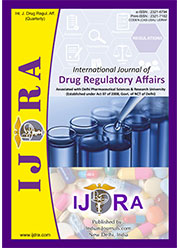Drug Labelling Regulations in the USA, Europe, and India: An Overview
Abstract
Labelling on drugs is a vital communication means that facilitates proper use of medicine safely and effectively by communicating core information to prescribing physicians and patients. Objective: This research aims to provide comparative examination of requirements for prescription labelling in three regulatory super jurisdictions: The United States of America, the European Union, and India. Data source: The research comprehensively analyses the regulatory directives for labelling exercises in these regulatory super jurisdictions, which include the guidelines of the U.S. FDA, the European Medicines Agency (EMA), and India's Central Drugs Standard Control Organization (CDSCO).
Conclusion: Regulatory expectations regarding key components such as labelling formats, required content, language, and patient safety and risk communication strategies are found to be majorly similar and divergent. This study identified regulatory gaps, industry challenges, and potential harmonization strategies to facilitate global trade. By understanding these frameworks, stakeholders can navigate compliance more efficiently, fostering growth in labelling practices across the USA, Europe, and India.
Downloads
References
https://www.ecfr.gov/current/title-21/chapter-I/subchapter-C/part-201/subpart-C
2. Wikipedia contributors. Drug labelling [Internet]. Wikipedia; [cited 2025 Jan 25]. Available from:
https://en.wikipedia.org/wiki/Drug_labelling
3. Medicines and Healthcare products Regulatory Agency. Best practice guidance on the labelling and packaging of medicines [Internet]. London: MHRA; 2015 Nov [cited 2025 Jan 25]. Available from:
https://www.gov.uk/government/uploads/system/uploads/attachment_data/file/474366/Best_practice_guidance_Labeling_and_packaging_of_medicines.pdf
4. Shrank WH, Agnew-Blais J, Choudhry NK, Wolf MS, Orav EJ, Avorn J, et al. A patient-centered prescription drug label to promote appropriate medication use and adherence [Internet]. Arch Intern Med. 2007 [cited 2025 Aug 16];167(16):1648–55. Available from:
https://www.researchgate.net/publication/306329118_A_Patient-Centered_Prescription_Drug_Label_to_Promote_Appropriate_Medication_Use_and_Adherence
5. Shrank WH, Avorn J, Rolon C, Shekelle P. Effect of content and format of prescription drug labels on readability, understanding, and medication use: a systematic review. Ann Pharmacother. 2007;41(5):783–801. Available from: https://www.researchgate.net/publication/51390229_Effect_of_Content_and_Format_of_Prescription_Drug_Labels_on_Readability_Understanding_and_Medication_Use_A_Systematic_Review
6. Wolf MS, Davis TC, Shrank W, Neuberger M, Parker RM. To err is human: patient misinterpretations of prescription drug label instructions. Patient Educ Couns. 2007;67(3):293–300. Available from:
https://pubmed.ncbi.nlm.nih.gov/17587533/
7. Makvana SH, Deshpande S, Zaveri M. Comparative analysis of drug labeling requirements in the USA and India: regulatory frameworks and compliance standards. Int J Pharm Sci. 2024;2(6):701–7. Available from:
https://www.ijpsjournal.com/article/Comparative+Analysis+Of++Drug+Labeling++Requirements+In+The+USA+And+India+Regulatory+Frameworks+And+Compliance+Standards
8. U.S. Food and Drug Administration. Requirements on content and format of labeling for human prescription drug and biological products [Internet]. Fed Regist. 2006 Jan 24 [cited 2025 Feb 02];71(15):3922–97. Available from:
https://www.federalregister.gov/documents/2006/01/24/06-545/requirements-on-content-and-format-of-labeling-for-human-prescription-drug-and-biological-products
9. Global Research Online [Internet]. [cited 2025 Mar 14]. Available from:
https://globalresearchonline.net/journalcontents/v67-2/10.pdf
10. Webretailer. EU product regulations [Internet]. [cited 2025 Apr 17]. Available from:
http://www.webretailer.com/lean-commerce/eu-product-regulations/
11. Royal Pharmaceutical Society. Summary of product characteristics [Internet]. [cited 2025 Mar 23]. Available from:
https://www.rpharms.com/development/trainee-pharmacists/product-characteristics-summary
12. U.S. Food and Drug Administration. Labeling for human prescription drug and biological products – implementing the PLR content and format requirements. Silver Spring (MD): FDA; [cited 2013 Feb 23] Available from:
https://www.fda.gov/files/drugs/published/Labeling-for-Human-Prescription-Drug-and-Biological-Products---Implementing-the-PLR-Content-and-Format-Requirements.pdf
13. Parate N. Labeling and pharmacovigilance: safeguarding safety and accuracy [Internet]. Freyr Solutions. 2023;14(2):67–9 [cited 2025 Sep 14]. Available from:
https://www.freyrsolutions.com/blog/labeling-and-pharmacovigilance-safeguarding-safety-and-accuracy
14. Baird M. The future of labels: embracing digital technology for enhanced efficiency. Schlafender Hase. [cited 2025 Mar 3];68(4):89–92. Available from:
https://www.schlafenderhase.com/shblog/the-future-of-labels-embracing-digital-technology-for-enhanced-efficiency
15. Freyr Solutions. Enhancing patient safety: the role of QR code implementation in pharma labeling [Internet]. 2024 [cited 2025 Sep 14];24(6):152–5. Available from:
https://www.freyrsolutions.com/blog/enhancing-patient-safety-the-role-of-qr-code-implementation-in-pharma-labeling
16. Kresankova K. 8 trends shaping the future of drug labeling. Schlafender Hase [Internet]. 2025 Jan 12 [cited 2025 Sep 14]. Available from:
https://www.schlafenderhase.com/insights/8-trends-drug-labeling
17. Vredenburgh AG, Zackowitz IB. Drug labeling and its impact on patient safety [Internet]. Work. 2009;33(2):169–74 [cited 2025 Sep 14]. Available from:
https://www.researchgate.net/publication/26773524_Drug_labeling_and_its_impact_on_patient_safety
18. Parate N. Harmonizing labeling for multiple product variants: ensuring safety and compliance [Internet]. Freyr Solutions. 2023;16(3):78–83 [cited 2025 Sep 14]. Available from:
https://www.freyrsolutions.com/blog/harmonizing-labeling-for-multiple-product-variants-ensuring-safety-and-compliance

This work is licensed under a Creative Commons Attribution-NonCommercial 4.0 International License.
The International Journal of Drug Regulatory affairs require a formal written transfer of copyright from the author(s) for each article published. We therefore ask you to complete and return this form, retaining a copy for your records. Your cooperation is essential and appreciated. Any delay will result in a delay in publication.
I/we have read and agree with the terms and conditions stated Page 2 of this agreement and I/we hereby confirm the transfer of all copyrights in and relating to the above-named manuscript, in all forms and media, now or hereafter known, to the International Journal of Drug Regulatory affairs, effective from the date stated below. I/we acknowledge that the IJDRA is relying on this agreement in publishing the above-named manuscript. However, this agreement will be null and void if the manuscript is not published in the IJDRA.
Download link for COPYRIGHT FORM







